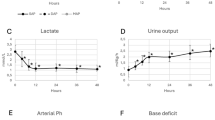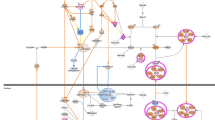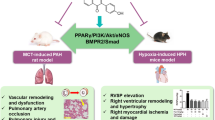Abstract
ABSTRACT: Reactive oxygen metabolites appear to modulate pulmonary vascular changes. To study the effects of free radical formation in vivo, we investigated five groups of young pigs by recording hemodynamic changes after xanthine oxidase infusion alone and after pretreatment with hypoxanthine or possible blocking agents. The pulmonary vascular pressure increased rapidly in the groups without inhibition reaching maximum levels 25 min after the start of the experiment. The pulmonary artery blood flow declined toward minimum values at the same time. Compared to baseline levels, the calculated vascular lung resistance increased by 300% when the pigs were pretreated with hypoxanthine, and by 150% when xanthine oxidase was given alone. These findings suggest enhanced pulmonary vasoconstriction as a result of high initial hypoxanthine levels probably capable of forming larger quantities of oxygen radicals. The vascular reaction was attenuated when the pigs were pretreated with indomethacin (cyclooxygenase inhibitor) or allopurinol (xanthine oxidase inhibitor). Furthermore, the presence of catalase (hydrogen peroxide scavenger) reduced the pulmonary vasoconstriction significantly. We observed less decline in arterial oxygen tension and oxygen saturation when the animals had been pretreated with inhibitory agents, compared to the blood gas changes found in the xanthine oxidase group. The systemic pressure recordings in the carotid artery remained at baseline levels in all groups. We conclude that oxygen radicals formed by the hypoxanthine-xanthine oxidase system produce severe pulmonary vascular constriction in young pigs.
Similar content being viewed by others
Log in or create a free account to read this content
Gain free access to this article, as well as selected content from this journal and more on nature.com
or
Author information
Authors and Affiliations
Rights and permissions
About this article
Cite this article
Sanderud, J., Norstein, J. & Saugstad, O. Reactive Oxygen Metabolites Produce Pulmonary Vasoconstriction in Young Pigs. Pediatr Res 29, 543–547 (1991). https://doi.org/10.1203/00006450-199106010-00005
Received:
Accepted:
Issue date:
DOI: https://doi.org/10.1203/00006450-199106010-00005
This article is cited by
-
Oxygen therapy of the newborn from molecular understanding to clinical practice
Pediatric Research (2019)
-
The fetal circulation, pathophysiology of hypoxemic respiratory failure and pulmonary hypertension in neonates, and the role of oxygen therapy
Journal of Perinatology (2016)
-
Considerations in the management of hypoxemic respiratory failure and persistent pulmonary hypertension in term and late preterm neonates
Journal of Perinatology (2016)
-
Molecular physiopathogenetic mechanisms and development of new potential therapeutic strategies in persistent pulmonary hypertension of the newborn
Italian Journal of Pediatrics (2015)
-
Relationship between elevated lipid peroxides, vitamin E deficiency and hypertension in preeclampsia
Molecular and Cellular Biochemistry (1995)



